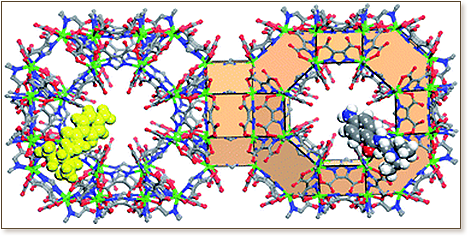

 The design and synthesis of new finely tunable porous materials has spurred interest in developing novel uses in a variety of systems. Zeolites, inorganic materials with high thermal and mechanical stability, in particular, have been widely examined for use in applications such as catalysis, ion exchange and separation. A relatively new class of inorganic-organic hybrid materials known as metal-organic frameworks (MOFs) have recently surfaced, and many have exhibited their efficiency in potential applications such as ion exchange and drug delivery. A more recent development is the design and synthesis of a subclass of MOFs based on zeolite topologies (i.e. ZMOFs), which often exhibit traits of both zeolites and MOFs. Bio-compatible hydrogels already play an important role in drug delivery systems, but are often limited by stability issues. Thus, the addition of ZMOFs to hydrogel formulations is expected to enhance the hydrogel mechanical properties, and the ZMOF-hydrogel composites should present improved, symbiotic drug storage and release for delivery applications. Herein we present the novel composites of a hydrogel with a zeolite-like metal-organic framework, rho-ZMOF, using 2-hydroxyethyl methacrylate (HEMA), 2,3-dihydroxypropyl methacrylate (DHPMA), N-vinyl-2-pyrolidinone (VP) and ethylene glycol dimethacrylate (EGDMA), and the corresponding drug release. An ultraviolet (UV) polymerization method is employed to synthesize the hydrogels, VP 0, VP 15, VP 30, VP 45 and the ZMOF-VP 30 composite, by varying the VP content (mol%). The rho-ZMOF, VP 30, and ZMOF-VP 30 composite are all tested for the controlled release of procainamide (protonated, PH), an anti-arrhythmic drug, in phosphate buffer solution (PBS) using UV spectroscopy.
The design and synthesis of new finely tunable porous materials has spurred interest in developing novel uses in a variety of systems. Zeolites, inorganic materials with high thermal and mechanical stability, in particular, have been widely examined for use in applications such as catalysis, ion exchange and separation. A relatively new class of inorganic-organic hybrid materials known as metal-organic frameworks (MOFs) have recently surfaced, and many have exhibited their efficiency in potential applications such as ion exchange and drug delivery. A more recent development is the design and synthesis of a subclass of MOFs based on zeolite topologies (i.e. ZMOFs), which often exhibit traits of both zeolites and MOFs. Bio-compatible hydrogels already play an important role in drug delivery systems, but are often limited by stability issues. Thus, the addition of ZMOFs to hydrogel formulations is expected to enhance the hydrogel mechanical properties, and the ZMOF-hydrogel composites should present improved, symbiotic drug storage and release for delivery applications. Herein we present the novel composites of a hydrogel with a zeolite-like metal-organic framework, rho-ZMOF, using 2-hydroxyethyl methacrylate (HEMA), 2,3-dihydroxypropyl methacrylate (DHPMA), N-vinyl-2-pyrolidinone (VP) and ethylene glycol dimethacrylate (EGDMA), and the corresponding drug release. An ultraviolet (UV) polymerization method is employed to synthesize the hydrogels, VP 0, VP 15, VP 30, VP 45 and the ZMOF-VP 30 composite, by varying the VP content (mol%). The rho-ZMOF, VP 30, and ZMOF-VP 30 composite are all tested for the controlled release of procainamide (protonated, PH), an anti-arrhythmic drug, in phosphate buffer solution (PBS) using UV spectroscopy.